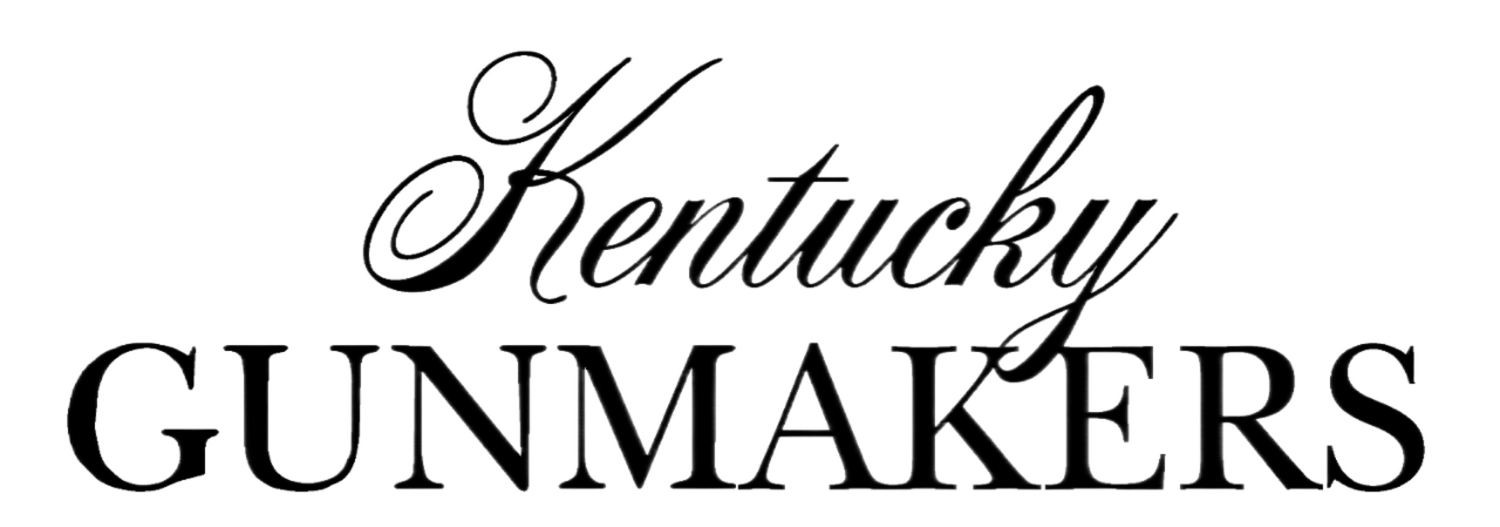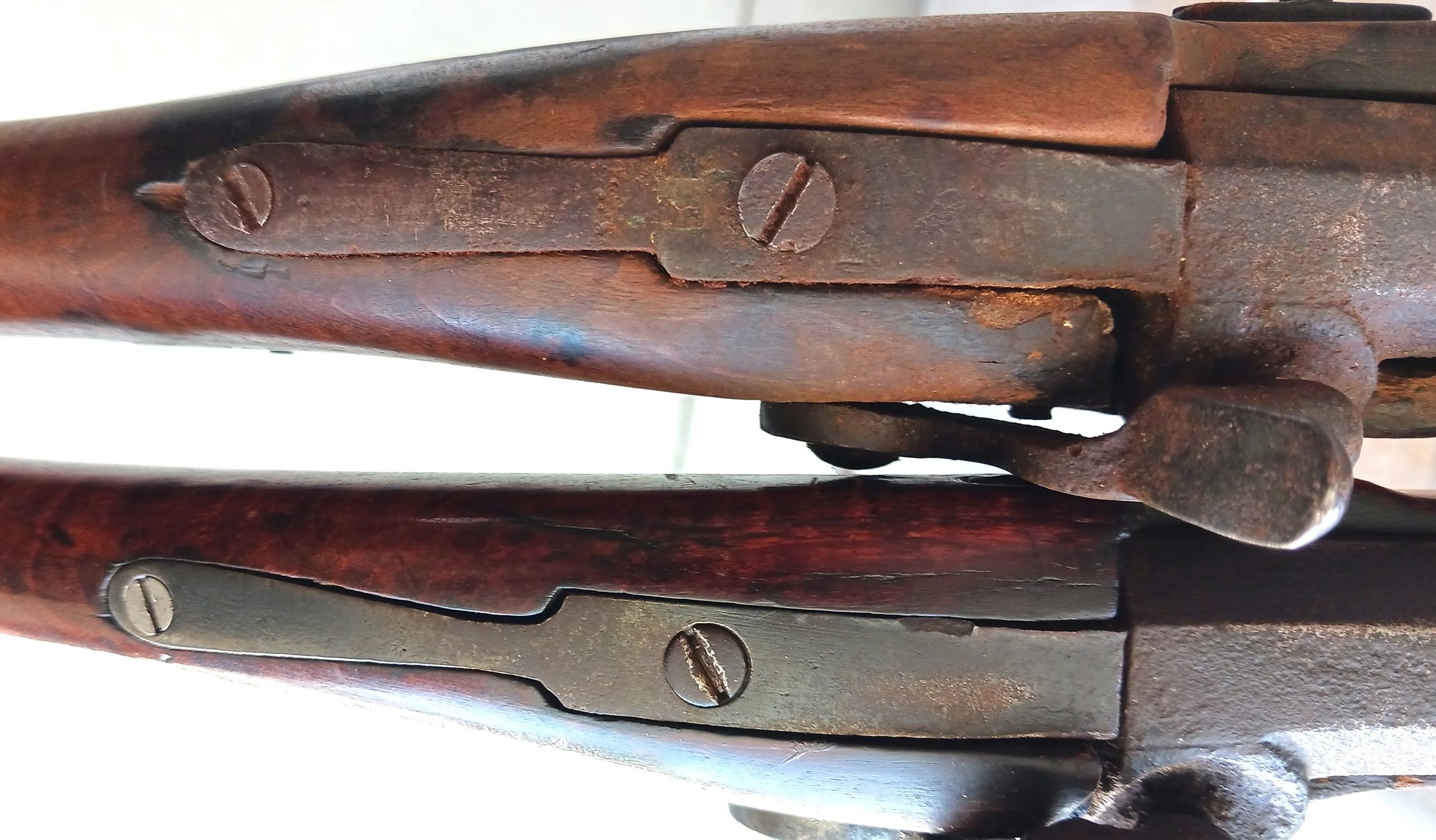The Prodigal Son Comes Home, A Lost Jacob Rizer Rifle ©
Foreword: A heavily worn half-stocked rifle of unknown origin sat in a Colorado gun shop for over a year gathering dust until the author stumbled across it one night on an internet search. The rifle, shown in Figure No.1, reminded him of a rifle in his collection. When he pulled his rifle out and compared it to the internet rifle, he was amazed at all the similarities. His gun was a half-stocked rifle signed “J. Rizer” that was made by Jacob Rizer of Bardstown, Kentucky, about 1845. The internet rifle undoubtedly had the same roots.
Figure No.1: This worn rifle with rusty barrel has no visible signature. The gun’s triangular butt, long barrel, and double-spurred guard with a “square shoulder” above the rear spur were Kentucky details and caught the author’s eye. The gun reminded him of a similar Kentucky gun in his collection signed ‘J. Rizer.” Barrel: 43-1/2” with .38 caliber bore. Author’s collection, photos by author.
Rizer Rifles: The author has collected early Kentucky firearms for many years. His favorite guns are from the Bardstown School centered around Nelson County where the state’s most highly decorated rifles were made. Jacob Rizer was Bardstown’s best-known gunsmith and instrumental in establishing the Bardstown School where he made many fine rifles. The author has several Bardstown guns in his collection; one is a mid-1840s half-stocked rifle found in Iowa several years ago. The gun is rather plain with the script signature “J. Rizer” on the barrel and is shown in Figure No.2. The barrel signature is shown in Figure No.3. While not Rizer’s finest work, any Rizer rifle is a major prize down in Kentucky, so it was a good addition for the author that was made even better when it helped identify the heavily worn internet rifle in Colorado.
Figure No.2: This “J. Rizer” signed rifle has a double-spurred guard and Rizer’s mid-1840s “chunky” cheekpiece that help date it about 1845. The grip area was worn through to the ramrod channel and a brass wear plate added to cover the damage. The back- action lock is marked “C. Baker” and stock wood is strongly figured curly maple. Barrel: 46-1/2” with .32 caliber bore. Author’s collection, photos by author.
Figure No.3: The ca. 1845 Rizer rifle is signed “J. Rizer” in script and is typical of all Rizer signatures throughout his career. His “z” had a longer tail on early guns, but during the percussion era the tail was lost, making his “z” look almost like an “n.”
Figure No.4: Cheekpieces on Rizer’s mid-1840s rifles were larger than on his earlier guns and often referred to as his “chunky” cheekpieces.
The Prodigal Son: When the author came across the old, worn half-stocked rifle, it reminded him of a signed Rizer rifle in his collection. The worn rifle had traveled as far west as Colorado before it was retired, apparently to the corner of an old barn where it got “weathered” for many years. When the author compared the rifle to his signed Rizer rifle, it was immediately obvious the rifles shared many important details and were made in the same shop by the same gunsmith… Jacob Rizer. The author called the Colorado shop, discussed the gun, and after a little haggling purchased it. A week later the gun arrived, and while the barrel was too rusty to see any trace of a signature, the similarities to the author’s “J. Rizer” rifle were overwhelming. The rifles shared important details that included: stock architecture, strongly curled maple wood, Rizer's later style "chunky" cheekpiece, back-action locks marked "C. Baker," 2-screw tangs of same length and shape, same shaping of side-facing remnants, guards with a Kentucky-style square shoulder above the rear spur, same butt plates and lock bolt washers, same patent breeches, and both guns had long barrels with three ramrod pipes. Forestock terminations differed, but both guns were otherwise almost identical. Many similarities can be seen in Figures No.4, No.5 and No.6. The old rifle had finally come home where it was appreciated and cared for, much like the prodigal son who finally came home after a hard, wandering life.
Figure No.5: The front side of the unsigned rifle shows its strongly curled maple stock, back-action lock marked “C. Baker, and Kentucky style guard with oval bow and “square shoulder” above the rear spur.
Figure No.6: The worn rifle’s stock has several cracks in front of the guard; a period repair keeps the wood from splitting worse. The butt’s architecture and “chunky” style cheekpiece mimic the signed rifle.
Attribution: The unsigned rifle may have once had a script signature, but years of wear and neglect obliterated any barrel markings. But other details were distinctive to Kentucky gunmaking and Rizer’s shop. More importantly, the gun closely resembled the author’s ca. 1845 Rizer rifle in almost every detail. The vivid curly maple on both guns was so similar that both stocks could have been cut from the same tree. Stock architecture was identical in butt shape, wrist curvature, comb length and shape, and perhaps most importantly cheekpiece shape in the “chunky” style used by Rizer in the mid-1840s. Butt plates and guards were identical, and toe plates were the same length with three screws. Both guards had Kentucky’s “square shoulder” above the rear spur where it runs up to meet the rear extension as seen in Figures No.7 and No.8. Even barrel tangs were the same length and shape with two screws as seen in Figure No.9, and lock bolt washers matched down to their short “locking” teats both pointing backwards. The double-set triggers differed slightly, but the unsigned rifle had the more distinctive Kentucky style triggers with its front “hair” trigger having a small “C” scroll on the back edge. The icing on the cake was matching back-action locks, both stamped “C. Baker,” with similar patent breeches.
Figure No.7: The worn Rizer rifle’s back-action lock is marked “C. Baker.” Note the patent breech shape, mid-1840s double-spurred guard, and forward trigger with a “Kentucky” style small scroll on its back edge.
Figure No.8: The signed Rizer rifle mimics the unsigned rifle with its back-action lock marked “C. Baker,” same patent breech, and double-spurred guard with a Kentucky “square shoulder” above the rear spur.
Figure No.9: Comparing the unsigned rifle’s tang [above] with the signed rifle’s tang [below] shows their similarity. Both tangs are similarly shaped and about the same length with two screws, i.e., tang bolt and tail screw.
When viewers look past the unsigned rifle’s condition issues, its similarities to the signed Rizer rifle are overwhelming, particularly in stocking where the gunmaker’s hand is often best seen on plainer rifles. Attributing the unsigned gun to Jacob Rizer is almost 100% certain. The only significant differences are the unsigned gun’s forestock termination, and to a lesser degree its barrel length, both visible in Figure No.10. Forestock terminations probably varied due to the unsigned rifle being a year or two earlier than the signed rifle, and its barrel a bit shorter to reduce the extra weight from a larger flat-to-flat diameter.
Figure No.10: A side-by-side comparison of the two Rizer rifles shows the same butt architecture, rear sight placement, butt plates, guards, three ramrod pipes, and back-action locks marked “C. Baker.” The only notable differences are terminations of forestocks and barrel lengths. Both guns have cast pewter nose caps, but the lower signed rifle has a more typical rear pipe set several inches behind its nose cap. The top rifle is a few years earlier with a .36 caliber bore compared to a .32 caliber bore and has a slightly larger diameter barrel flat-to-flat… made shorter to lessen its weight.
Summary: An unidentified rifle was discovered in a Colorado shop that displayed many details used by gunsmith Jacob Rizer of Bardstown, Kentucky. When compared to a signed Rizer rifle made about 1845, the unidentified gun was virtually the same gun, making an attribution to Rizer almost guaranteed. Stock architecture and major mountings were the same, back-action locks were marked “C. Baker,” and patent breeches had similar shapes. Years of exposure and barrel rust may have removed an original signature on the unidentified rifle, but it had so many matching elements when compared to the signed Rizer rifle that its attribution to Jacob Rizer was 99.9% certain.










